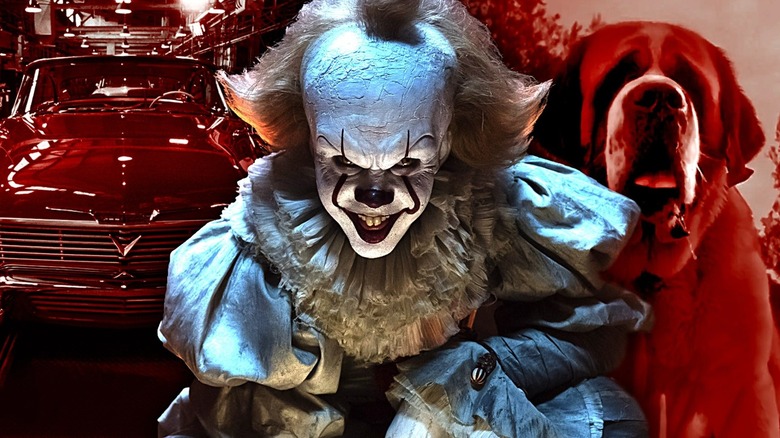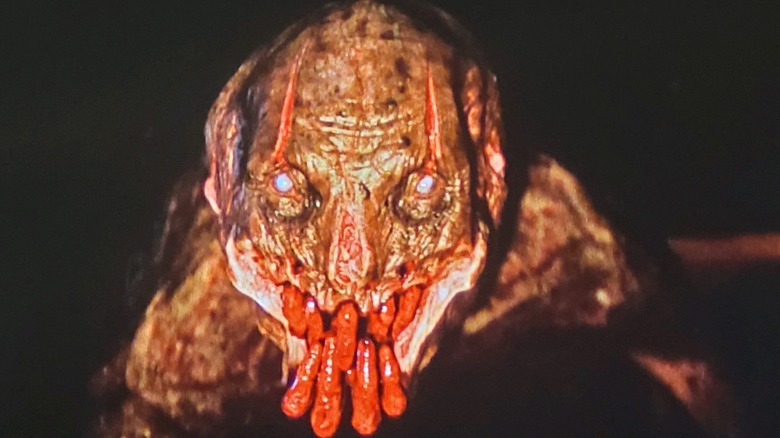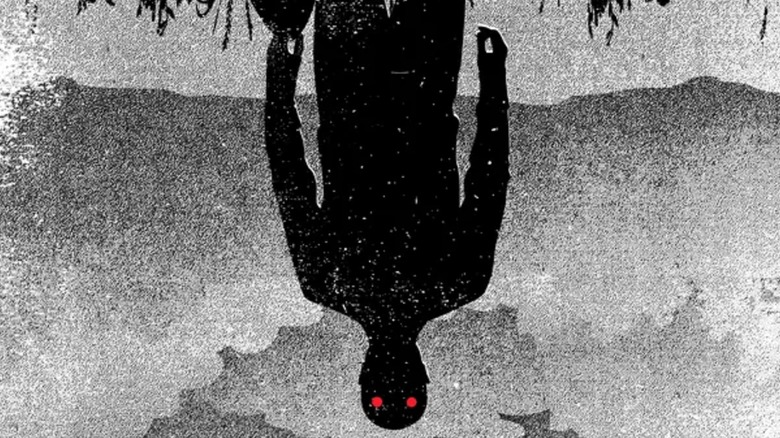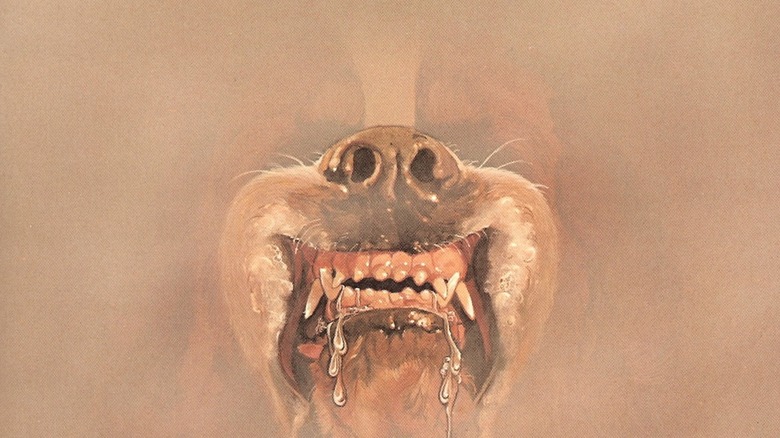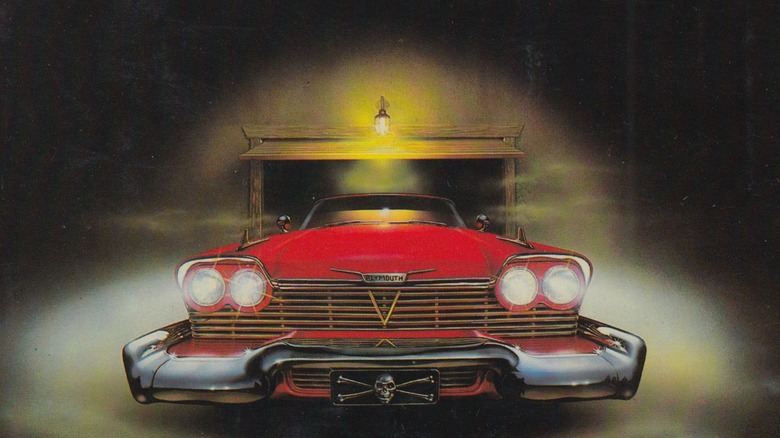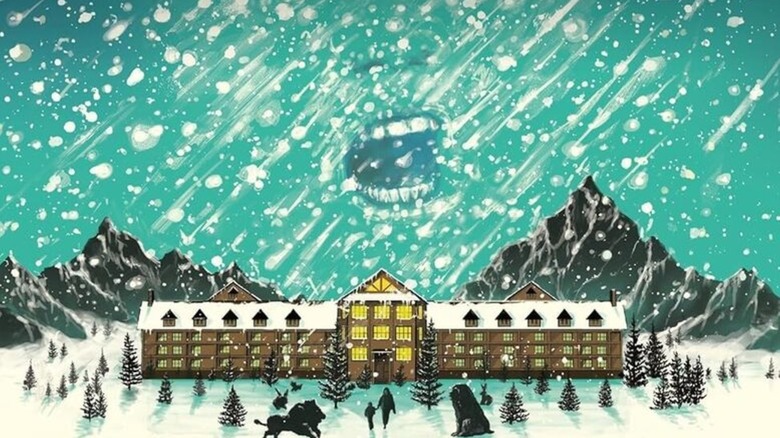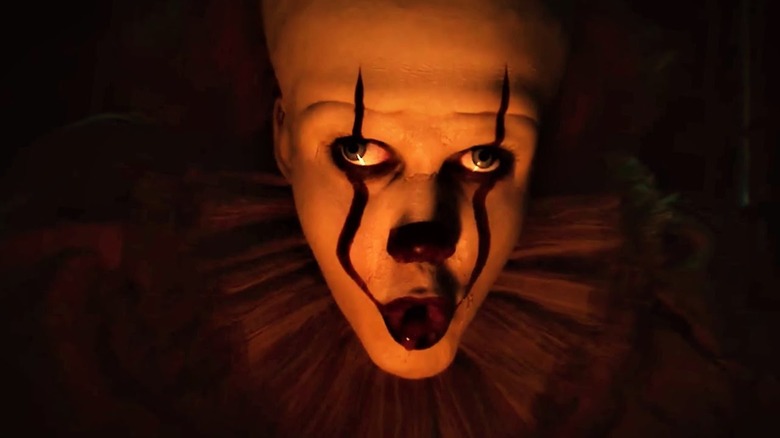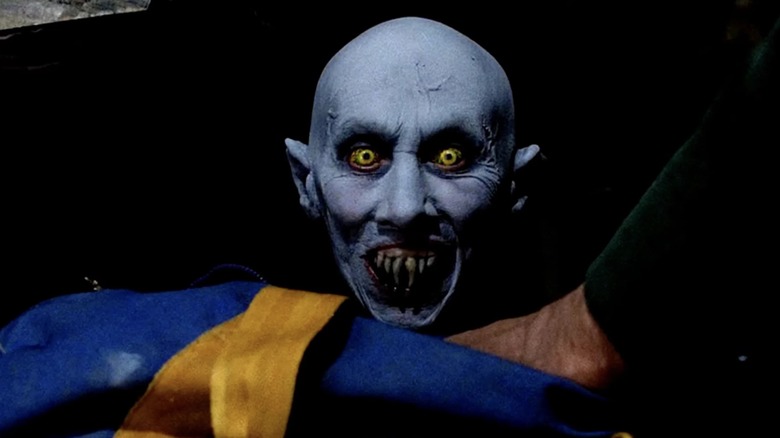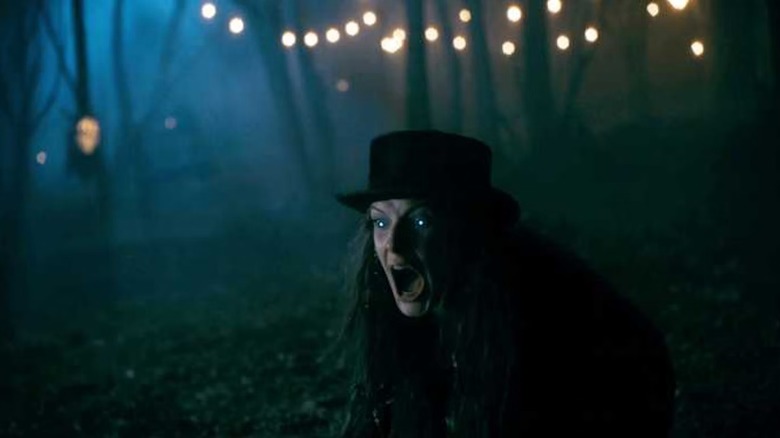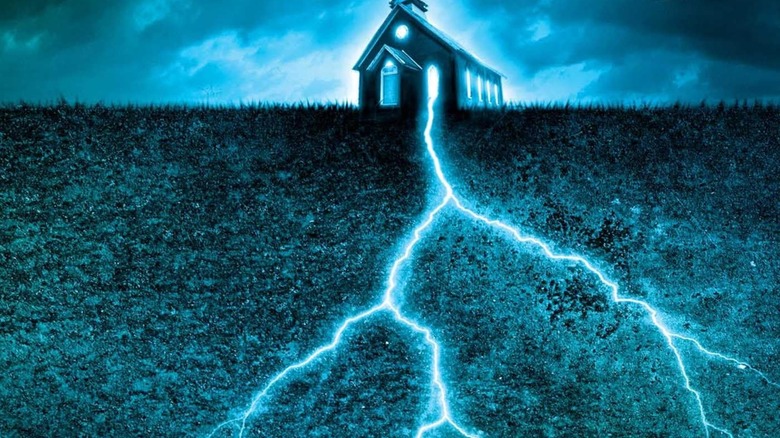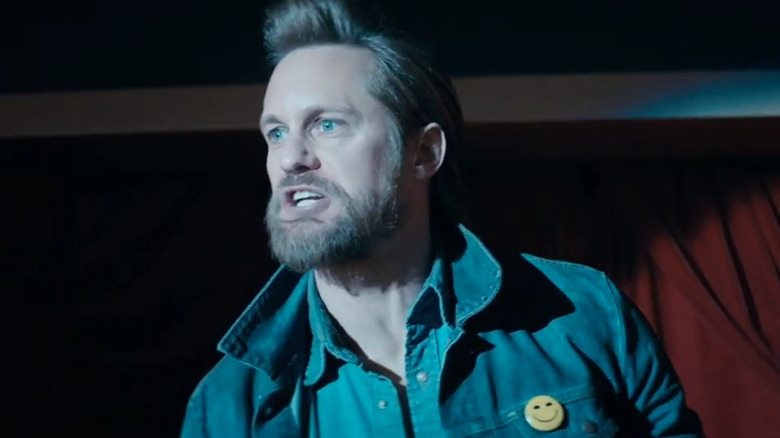10 Scariest Stephen King Monsters, Ranked
Stephen King makes no bones about turning humans into the real monsters of his stories wherever necessary. For all that Carrie White is a dangerous telekinetic, it's the banal teenage bully and a fanatic mother that puts her over the edge. "Firestarter" stars a rogue government agency willing to manipulate civilians, and "The Stand" may ultimately come down to cosmic horror and angelic good, but it all begins with our hubris among the natural world of viruses. It's up front stuff, but it's also not the only kind of horror King likes to put into play.
"True" monsters do lurk in King's stories, and while not every one of them is the creepiest thing ever put to page, everyone eventually finds a favorite critter to be horrified by. Some need more time to shine before they become standouts, and a few only serve to move the plot around. But others are truly scary, giving themselves a place of honor in the horror pantheon.
These are 10 of Stephen King's best monstrous creations, the scariest non-humans he's unleashed to date. Let's visit this monstrous gallery.
10. The Boogeyman
Possibly a contender for the greatest gap of time between a King publication and the obligatory adaptation, "The Boogeyman" first saw publication in a men's magazine in 1973 and gained wider acclaim in the 1978 collection "Night Shift," before hitting the big screen in 2023 with modern horror legend David Dastmalchian throwing in another of his emotional yet unsettling roles. Yet for all his rubbery excellence, Dastmalchian isn't the titular Boogeyman (which is shown above), and the film only dances around the truth of what it is. Where King's story makes it clear who the boogeyman really is, all Sadie (Sophie Thatcher) gets is an open door and a suspicion that her family's nightmare isn't over. Is even their therapist under suspicion? It's not clear.
In contrast, King's Boogeyman is every young parent's nightmare incarnate; an unknowable thing stalking and eventually killing defenseless children despite Mom and Dad's best efforts to halt it. In the story, its predations pass as crib deaths and other mundane tragedies. But the truth is even worse than these horrific real life possibilities: the Boogeyman has been masquerading as the one figure a grieving father can confide in, his psychiatrist. Like Pennywise, this barely described inhuman thing likes only one flavor of meal better than a child's demise: an adult's maddened horror.
9. El Cuco, The Outsider
Inspired by old Portuguese tales of a nightmarish child eater, "The Outsider" takes some cues from the cult horror film "Fallen" with its bloody method of surfing from body to body, leaving tragedies and insensate horrors in its wake. But this El Cuco isn't just some Christian idea of a demon, nor is it as simple as its legend, especially in the HBO series adaptation. It's a hungering shape driven to leave scenes of despair and horror in its wake, all because it enjoys it. And possibly feeds on it.
"The Outsider," which turns into a surprise Holly Gibney outing for King fans who thought it was a standalone (and it still mostly is), is also possibly another tenuous link to King's larger universe of horrors. El Cuco's methods of mimicry and turning human emotions — it prefers grief — into a Big Gulp from Hell's favorite 7-11 may be familiar to those of us looking out for other members of Pennywise's extended cosmic family. There's no spider imagery here, thankfully, although the creature does eventually go to ground in a local cave network. It all comes through fairly clearly in the Max miniseries, where Cynthia Erivo ("Wicked"), as the unusual but adept PI Gibney, eventually leads Ralph (Ben Mendelsohn) and other survivors of the Outsider's stray damage to its lair for a final showdown.
More than anything else, though, El Cuco is a nightmare for anyone who's watched a person they care about abruptly turn into someone else entirely. El Cuco likes to leave no explanation behind if possible, though, and that makes it slightly less scary than Alzheimers and other diseases that we still can't defeat.
8. Cujo
Cujo, the St. Bernard at the heart of the novel of the same name, isn't a monster. He's a good boy, a lumbering fellow that loves kids and can't stop sticking his nose into things. It's that instinctual delight that catches him up with the real monsters here, and the rest of the novel contains heartbreaking moments from a dog's-eye view as rabies eats itself deeper into his blood.
There's nothing unnatural about rabies, either, but it's as monstrous a virus as anything we've ever discovered. A virus isn't sentient, but it is structured to protect and replicate itself, causing behaviors that can seem eerie to us. There's even a theory that the reason we find zombies and other uncanny valley behaviors so primally frightening is because we're subconsciously alert to the threat of rabies. The violence rabies can cause in its victims is a sure way of sharing the virus, via the bites and scratches that can ensue.
But "Cujo" blends one wisp of supernatural horror into the mix, with the shadow of Frank Dodd, one of several antagonists in "The Dead Zone" who still haunts the town of Castle Rock. It's implied that there's just enough spiritual evil floating around to make a bad situation worse (though a real dog attack inspired the story). On the whole, Frank can't overpower the sheer horror of rabies and what it turns poor Cujo into, but he does add an extra layer of dread to the monstrous proceedings.
Adapted in 1983, the film follows the novel's mundane beats. No ghosts haunt Sheriff Bannerman, even though David Cronenberg's "The Dead Zone" would release that same year. It'll be interesting to see how the upcoming Netflix adaptation handles the mix of reality and horror that shapes poor Cujo's tragedy.
7. Christine
There's a nostalgic romance to Christine, and that's what makes her such an easy lure to the lonely Arnie Cunningham. An early bit of insight into what creates an incel is woven into the fringes of "Christine," as Arnie, a good natured nerd with an overbearing family and the perfect all American boy as his best friend, gradually becomes toxic as the beautiful red car takes its place at the center of his life. He takes on idiot alpha male behaviors, gets increasingly aggressive, and prioritizes his own needs — and his car's needs — over everyone else, isolating himself.
Arnie's locked into an abusive relationship, one that's turned him into the worst version of himself, and it's not a mistake that this most dudely of status symbols, a car, is what causes the change. Christine is implied to be something like a demon, empowered by the worst parts of its original owner's spirit, a rotten to the core old man named LeBay. But is the car really LeBay, or does Christine have her own agenda? Did she love her owner so much that she's reshaping her new caretaker into his equal? It's never clear. The only thing we know is that this gorgeous old Plymouth Fury won't ever stop driving after whatever she hates most.
A crisply streamlined adaptation by horror legend John Carpenter (also released in 1983, alongside "Cujo" and "The Shrouds" director David Cronenberg's "The Dead Zone," suggesting something was in the water that year) nails the high points of King's monster car, complete with one of the coolest uses of special effects as Christine heals herself after a beating. More subtle than King's ending, Carpenter leaves Christine's future vague, suggesting she might even be able to recover from being scrapped down to a cube.
6. The Overlook Hotel
The term "Genius loci" comes from classical Rome, in which important places — and the spiritually risky crossroads — are imbued with patron ghosts. It's a popular concept in fantasy and science fiction. But Stephen King made sure horror got into the act with "The Shining," where a fancy old hotel in the Colorado mountains has become its own malignant entity thanks to decades of human sin and sacrifice.
The Overlook Hotel is a swanky place for the jet set and the ski kids, but gilded elitism draws in people who want to aspire to earn that sort of swag as much as it does those who already have it. Both groups, as fans of "The White Lotus" know, bring their own kinds of terrible behavior on vacation with them. By the time Jack Torrance becomes the winter caretaker, the Overlook Hotel knows exactly what kinds of horrors it enjoys most, and presses Jack into sharing them with it.
Jack's a troubled guy in the novel, but he was far from the hellish host the hotel wanted, until this ghastly place wheedled it out of him. It's the key to why King has an issue with Kubrick's excellent movie: Jack Nicholson's off-kilter performance suggests this guy came to hotel ready for evil. That's not true of the novel's Torrence, who's as much a victim of this semi-sentient hellhole as his psychic son, Danny. The literally damned place even comes back in "Doctor Sleep" as the only place that could possibly match a force as hungry and cruel as itself.
Mike Flanagan's adaptation, meanwhile, not only manages to thoroughly evoke the Overlook's evil, but threads the needle between King's "The Shining" and Kubrick's visually iconic adaptation. The lesson: Stick with budget motels.
5. Pennywise
Between ICP, that weird clown scare in 2016, and the fact that John Wayne Gacy is, mercifully, dead, clowns just aren't as scary as they used to be. It's a fact that's lampshaded in "It: Chapter Two," when Pennywise (Bill Skarsgard, as seen above) comes across a kid that's entirely unimpressed with his usual schtick and gets ready to leave until he changes tactics. The clown thing hit a lot harder in 1986, the year "It" was originally published, though, fueled by a generation that had grown up on all the same weekend movie horrors as King himself.
Even Pennywise's other gags don't hit the way they used to. The Blob has a goofy Philadelphia festival dedicated to it, the Crawling Eye that scared Richie so badly is MST3K fodder, and there's worse things in our history books than a scary clown that shows up every 47 years. The news has worse horrors on offer every day. Though we won't deny that there's still something creepy about Pennywise in his clown form.
Pennywise the Dancing Clown may no longer be quite as horrific as he used to be, but when It reveals itself as the cosmic horror it really is, that's still a terrific moment that laid the groundwork for years of speculation about other King horrors. From Dandelo in "The Dark Tower" to the previously mentioned Outsider, the scariest thing to still persist about It is that she may be far from alone.
4. Kurt Barlow
Stephen King took one solid whack at the mythology of the classical vampire in "Salem's Lot," and he nailed it well enough that he never really had to try it again. Kurt Barlow is a proper vamp of the Nosferatu type, with his original 1979 screen adaptation getting King's description across with a glowing-eyed hairless thing (as seen above, played by Reggie Nalder) happy to predate on anyone. Blood fuels his ability to gradually pass as more human, but at no point does Barlow look much better than his peers from "Midnight Mass" or, again, Bill Skarsgård as Count Orlok. The evil is too visible in him, and it's a power strong enough to overcome a priest's already weakened faith.
It's that capability that turns Barlow into something more than the average scary vampire, coming right up against what's supposed to be every person's saving throw against these bloodsuckers, the protection of the Christian God. Plus, not even blinking is a hell of a baller move. It's one of the most harrowing scenes in horror fiction, as Father Callahan's faith crumbles into nothing and, later, banishes him to some dark regions of the larger "Dark Tower" universe until he finds a way to redeem himself. It's a central moment to the story, one that confirms just how dangerous Barlow is.
This moment is completely missing from the Max 2024 adaptation, making it just one more thing this version manages to fumble. Barlow's sneering, fearless evil takes what's intriguing about vampires and makes it legitimately scary — and worse, his children outlive him, in defiance of the usual master vampire tropes.
3. The True Knot
The antagonists of "Doctor Sleep" are a crew called The True Knot, led by their strongest member, Rose the Hat (as seen above, played by "Dune" star Rebecca Ferguson), and they're a much different kind of vampire than Barlow. Empathetic, or even a kind of energy vampire, they're closer to Colin Robinson of "What We Do in the Shadows," but the Knot are humorless, cruel, and would never deign to feed off a Long Island city council meeting. Each member of them, from Grampa Flick to Rose, may have once been a human being, but they've all long since sold away any shred of their soul for a kind of immortality bought at a vile price.
To stay alive as a member of the Knot, they have to feed on children's souls. And not just any children; they have to be kids with the latent psychic ability Danny Torrance knew as "the shining." Their efficiency and necessary cruelty is put into plain sight when the Knot abducts a young baseball player named Bradley. Bradley's death is one of the darkest reads in King's fiction, and it makes it abundantly clear what these monsters will do to stay alive. Mike Flanagan's adaptation brings that moment of monstrosity over with full force, with a scene so harrowing — even to film! — that it would be edited down long before it hit the screen.
The True Knot can feel emotions and they clearly care about each other, but everyone else may as well be animals. They've chosen this life, committed to it via an irredeemable ritual that requires those innocent souls, and when they die, they become nothing at all.
2. The Mother of the Null
"Revival" has a mixed response from some fans, but it's also the most old school of King's modern novels. It's a pulpy ride from start to finish, with faith healers and Frankenstein experiments and references to De Vermis Mysteriis, a fictional eldritch text that's been showing up in Lovecraft-style novels since Robert Bloch coined it in 1935. It's also the source of one of the most depressing, nihilistic ideas of the afterlife since Kentaro Miura's "Berserk," and a love letter to one of the first riffs on this kind of story, Arthur Machen's "The Great God Pan."
The Mother of the Null isn't even a true antagonist. It's a power, a thing of cosmic monstrosity that rules over the spiritual wasteland that awaits us all instead of Heaven or Hell. It's a limbo of the worst sort, with no mercy or acknowledgement for our acts in life, and our souls fated to be fed to these unknowable horrors. The Mother becomes aware of our reality just enough to attempt to kill our protagonist for intruding on her realm, but even that's just a meaningless lashing out. In the end, the protagonist knows that the Mother will be waiting for his soul after he dies, no matter what. How comforting.
1. Randall Flagg
Call him Walter o'Dim, call him the Walking Dude. It's unclear if King's darkest figure was ever capable of being human or if he was always some eternal tool of the Crimson King. All that's known for sure is that his first appearance was as the devilish ghast at the heart of Las Vegas in "The Stand," a man so dedicated to the cycle of Evil that even God's direct intervention merely set him back on his own unending wheel. His next role was as a faux-humble court wizard in "The Eyes of the Dragon," and then he became best known as Roland Deschain's foil, a wholly evil servant of Merlin in the Arthurian flavored "Dark Tower" saga. As the man in black, he fled across the desert, and the gunslinger will always follow close behind.
The Crimson King is a terrifying idea, to be sure, but in the end he's a paper tiger, a concept of evil locked away in the tower he craved. Flagg is the one with all the agency, the creature that ensures the King's will is done until he craves the ultimate power for himself. In the end, it's not Roland that finishes off Flagg, but his own lust to surpass his King and the King's mad heir, Mordred.
Without him, countless horrific acts would never have happened throughout all of Stephen King's creation. Flagg is King's terrible lynchpin, a merciless servant of chaos and cruelty. Even Pennywise would have to admit this monster's works are mightier than It's own, and they've done more lasting damage.
